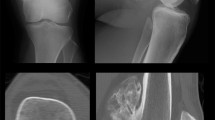Abstract
In orthopaedic surgery, resection of pelvic bone tumors can be inaccurate due to complex geometry, limited visibility and restricted working space of the pelvis. The present study investigated accuracy of patient-specific instrumentation (PSI) for bone-cutting during simulated tumor surgery within the pelvis. A synthetic pelvic bone model was imaged using a CT-scanner. The set of images was reconstructed in 3D and resection of a simulated periacetabular tumor was defined with four target planes (ischium, pubis, anterior ilium, and posterior ilium) with a 10-mm desired safe margin. Patient-specific instruments for bone-cutting were designed and manufactured using rapid-prototyping technology. Twenty-four surgeons (10 senior and 14 junior) were asked to perform tumor resection. After cutting, ISO1101 location and flatness parameters, achieved surgical margins and the time were measured. With PSI, the location accuracy of the cut planes with respect to the target planes averaged 1 and 1.2 mm in the anterior and posterior ilium, 2 mm in the pubis and 3.7 mm in the ischium (p < 0.0001). Results in terms of the location of the cut planes and the achieved surgical margins did not reveal any significant difference between senior and junior surgeons (p = 0.2214 and 0.8449, respectively). The maximum differences between the achieved margins and the 10-mm desired safe margin were found in the pubis (3.1 and 5.1 mm for senior and junior surgeons respectively). Of the 24 simulated resection, there was no intralesional tumor cutting. This study demonstrates that using PSI technology during simulated bone cuts of the pelvis can provide good cutting accuracy. Compared to a previous report on computer assistance for pelvic bone cutting, PSI technology clearly demonstrates an equivalent value-added for bone cutting accuracy than navigation technology. When in vivo validated, PSI technology may improve pelvic bone tumor surgery by providing clinically acceptable margins.







Similar content being viewed by others
References
Abraham, J. A. Recent advances in navigation-assisted musculoskeletal tumor resection. Curr. Orthop. Pract. 22(4):297–302, 2011.
Anselmetti, B. Tolérancement—Cotation de fabrication et métrologie, Vol. 3. Paris: Lavoisier, p. 334, 2003.
Brown, H., and R. Prescott. Applied Mixed Models in Medicine. 1st ed. New York: John Wiley & Sons, 1999.
Cartiaux, O., P. L. Docquier, L. Paul, B. G. Francq, O. Cornu, C. Delloye, B. Raucent, B. Dehez, and X. Banse. Surgical inaccuracy of tumor resection and reconstruction within the pelvis: an experimental study. Acta Orthop. 79:695–702, 2008.
Cartiaux, O., X. Banse, L. Paul, B. G. Francq, C.-E. Aubin, and P.-L. Docquier. Computer-assisted planning and navigation improves cutting accuracy during simulated bone tumor surgery of the pelvis. Comput. Aided Surg. 2012 Nov 26. [Epub ahead of print].
Cartiaux, O., L. Paul, P. L. Docquier, and X. Banse. Computer- and robot-assisted resection and reconstruction of pelvic bone tumours—a review. Eur. Musc. Rev. 6(2):125–130, 2011.
Cartiaux, O., L. Paul, P. L. Docquier, B. G. Francq, B. Raucent, E. Dombre, and X. Banse. Accuracy in planar cutting of bones: an ISO-based evaluation. Int. J. Med. Robot. 5:77–84, 2009.
Cartiaux, O., L. Paul, P. L. Docquier, B. Raucent, E. Dombre, and X. Banse. Computer-assisted and robot-assisted technologies to improve bone-cutting accuracy when integrated with a freehand process using an oscillating saw. J. Bone Joint Surg. Am. 92(11):2076–2082, 2010.
Cho, H. S., H. G. Kang, H. S. Kim, and I. Han. Computer-assisted sacral tumor resection. A case report. J. Bone Joint Surg. Am. 90:1561–1566, 2008.
Delloye, C., X. Banse, B. Brichard, P. L. Docquier, and O. Cornu. Pelvic reconstruction with a structural pelvic allograft after resection of a malignant bone tumor. J. Bone Joint Surg. Am. 89:579–587, 2007.
Dobbe, J. G., K. J. Pré, P. Kloen, L. Blankevoort, and G. J. Streekstra. Computer-assisted and patient-specific 3-D planning and evaluation of a single-cut rotational osteotomy for complex long-bone deformities. Med. Biol. Eng. Comput. 49(12):1363–1370, 2011.
Docquier, P. L., L. Paul, O. Cartiaux, C. Delloye, and X. Banse. Computer-assisted resection and reconstruction of pelvic tumor sarcoma. Sarcoma 125162, 2010. Epub 2010 Nov 28.
Enneking, W. F., and W. K. Dunham. Resection and reconstruction for primary neoplasms involving the innominate bone. J. Bone Joint Surg. Am. 60:731–746, 1978.
Fehlberg, S., S. Eulenstein, T. Lange, D. Andreou, and P. U. Tunn. Computer-assisted pelvic tumor resection: fields of application, limits, and perspectives. Recent Results Cancer Res. 179:169–182, 2009.
Fuchs, B., N. Hoekzema, D. R. Larson, C. Y. Inwards, and F. H. Sim. Osteosarcoma of the pelvis: outcome analysis of surgical treatment. Clin. Orthop. Relat. Res. 467:510–518, 2009.
Hafez, M. A., K. L. Chelule, B. B. Seedhom, and K. P. Sherman. Computer-assisted total knee arthroplasty using patient-specific templating. Clin. Orthop. Relat. Res. 444:184–192, 2006.
Han, I., Y. M. Lee, H. S. Cho, J. H. Oh, S. H. Lee, and H. S. Kim. Outcome after surgical treatment of pelvic sarcomas. Clin. Orthop. Surg. 2(3):160–166, 2010.
International, A. S. T. M. Standard F1839-08e1: Standard Specification for Rigid Polyurethane Foam for Use as a Standard Material for Testing Orthopedic Devices and Instruments. West Conshohocken, PA: ASTM International, 2008.
International Organization for Standardization. Standard 1101:2004: Geometrical Product Specifications (GPS)—Geometrical Tolerancing—Tolerances of Form, Orientation, Location and Run-Out (2nd ed.). Geneva, Switzerland: International Organization for Standardization, 2004.
Khan, F. A., J. D. Lipman, A. D. Pearle, P. J. Boland, and J. H. Healey. Surgical technique: computer-generated custom jigs improve accuracy of wide resection of bone tumors. Clin. Orthop. Relat. Res. 2013 Jan 5. [Epub ahead of print].
Krettek C., J. Geerling, L. Bastian, M. Citak, F. Rücker, D. Kendoff, and T. Hüfner. Computer aided tumor resection in the pelvis. Injury 35(Suppl 1):S-A79-83, 2004.
Kunz, M., J. F. Rudan, G. C. Wood, and R. E. Ellis. Registration stability of physical templates in hip surgery. Stud. Health Technol. Inform. 163:283–289, 2011.
Lewis, V. O. What’s new in musculoskeletal oncology. J. Bone Joint Surg. Am. 91:1546–1556, 2009.
Ng, V. Y., J. H. DeClaire, K. R. Berend, B. C. Gulick, and A. V. Lombardi, Jr. Improved accuracy of alignment with patient-specific positioning guides compared with manual instrumentation in TKA. Clin. Orthop. Relat. Res. 470(1):99–107, 2012.
Nunley, R. M., B. S. Ellison, J. Zhu, E. L. Ruh, S. M. Howell, and R. L. Barrack. Do patient-specific guides improve coronal alignment in total knee arthroplasty? Clin. Orthop. Relat. Res. 470(3):895–902, 2012.
Oka, K., T. Murase, H. Moritomo, and H. Yoshikawa. Corrective osteotomy for malunited both bones fractures of the forearm with radial head dislocations using a custom-made surgical guide: two case reports. J. Shoulder Elbow Surg. 21(10):e1–e8, 2012.
Ozaki, T., S. Flege, M. Kevric, N. Lindner, R. Maas, G. Delling, R. Schwarz, A. R. von Hochstetter, M. Salzer-Kuntschik, W. E. Berdel, H. Jürgens, G. U. Exner, P. Reichardt, R. Mayer-Steinacker, V. Ewerbeck, R. Kotz, W. Winkelmann, and S. S. Bielack. Osteosarcoma of the pelvis: experience of the cooperative osteosarcoma study group. J. Clin. Oncol. 21:334–341, 2003.
Paul, L., O. Cartiaux, P. L. Docquier, and X. Banse. Ergonomic evaluation of 3D plane positioning using a mouse and a haptic device. Int. J. Med. Robot. 5:435–443, 2009.
Pearle, A. D., D. Kendoff, and V. Musahl. Perspectives on computer-assisted orthopaedic surgery: movement toward quantitative orthopaedic surgery. J. Bone Joint Surg. Am. 91(Suppl.1):7–12, 2009.
Radermacher, K., F. Portheine, M. Anton, A. Zimolong, G. Kaspers, G. Rau, and H. W. Staudte. Computer assisted orthopaedic surgery with image based individual templates. Clin. Orthop. Relat. Res. 354:28–38, 1998.
Rivkin, G., and M. Liebergall. Challenges of technology integration and computer-assisted surgery. J. Bone Joint Surg. Am. 91:13–16, 2009.
Schkommodau, E., N. Decker, U. Klapper, K. Birnbaum, H. W. Staudte, and K. Radermacher. Pedicle Screw Implantation Using the DISOS Template System. In: Navigation and Robotics in Total Joint and Spine Surgery, edited by J. B. Stiehl, W. H. Konermann, and R. G. Haaker. Berlin: Springer-Verlag, 2003, pp. 501–505.
Sherman, C. E., M. I. O’Connor, and F. H. Sim. Survival, local recurrence, and function after pelvic limb salvage at 23 to 38 years of followup. Clin. Orthop. Relat. Res. 470(3):712–727, 2012.
So, T. Y., Y. L. Lam, and K. L. Mak. Computer-assisted navigation in bone tumor surgery: seamless workflow model and evolution of technique. Clin. Orthop. Relat. Res. 468(11):2985–2991, 2010.
Staudte, H. W., E. Schkommodau, F. Portheine, and K. Radermacher. Pelvic Osteotomy with Template Navigation. In: Navigation and Robotics in Total Joint and Spine Surgery, edited by J. B. Stiehl, W. H. Konermann, and R. G. Haaker. Berlin: Springer-Verlag, 2003, pp. 455–463.
White, D., K. L. Chelule, and B. B. Seedhom. Accuracy of MRI vs CT imaging with particular reference to patient specific templates for total knee replacement surgery. Int. J. Med. Robot. 4(3):224–231, 2008.
Wong, K. C., S. M. Kumta, K. Y. Sze, and C. M. Wong. Use of patient-specific CAD/CAM surgical jig in extremity bone tumor resection and custom prosthetic reconstruction. Comput. Aided Surg. 1–10, 2012, Early Online.
Wong, K. C., S. M. Kumta, K. H. Chiu, K. W. Cheung, K. S. Leung, P. Unwin, and M. C. Wong. Computer assisted pelvic tumor resection and reconstruction with a custom-made prosthesis using an innovative adaptation and its validation. Comput. Aided Surg. 12:225–232, 2007.
Conflict of interest
No benefits in any form have been received or will be received from a commercial party related directly or indirectly to the subject of this article. Grants from the Brussels-Capital Region (“Brains Back to Brussels” grant BB2B 2012-1-05) and Fondation Belge contre le Cancer (grant SCIE 2006/20) were used to pay for the salaries of laboratory personnel and for purchase of the bone models and surgical supplies.
Author information
Authors and Affiliations
Corresponding author
Additional information
Associate Editor Mona Kamal Marei oversaw the review of this article.
Rights and permissions
About this article
Cite this article
Cartiaux, O., Paul, L., Francq, B.G. et al. Improved Accuracy with 3D Planning and Patient-Specific Instruments During Simulated Pelvic Bone Tumor Surgery. Ann Biomed Eng 42, 205–213 (2014). https://doi.org/10.1007/s10439-013-0890-7
Received:
Accepted:
Published:
Issue Date:
DOI: https://doi.org/10.1007/s10439-013-0890-7




